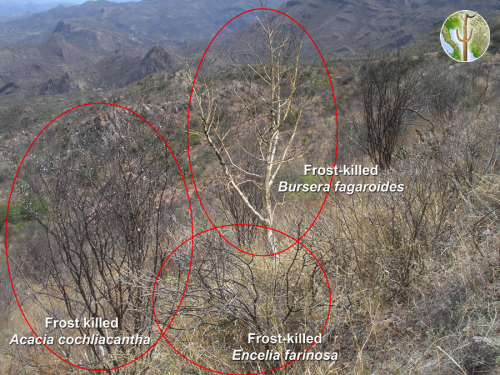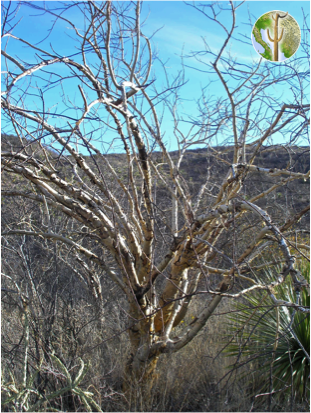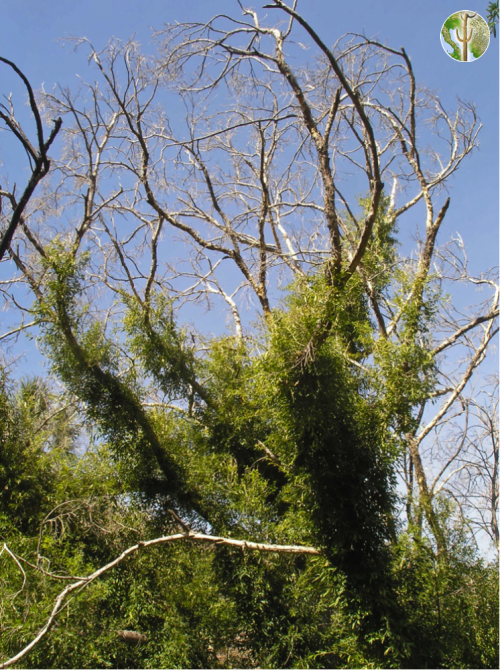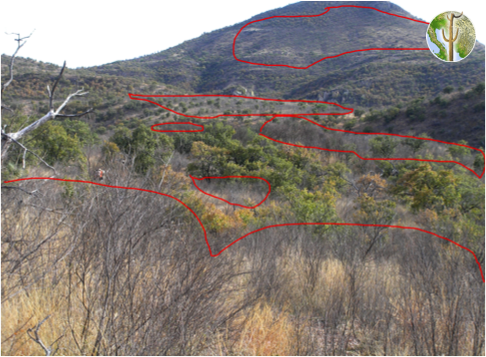Plant Communities and the 2011 frost on the Northern Jaguar Preserve

 February 2nd and 3rd 2011 laid a heavy hand on the NJP reserve. An arctic air mass descended on southwestern North America, stretching its influence south of its typical reach. Individual species had their numbers reduced drastically. The makeup and distribution of some plant communities were altered. Rules that had governed species survival for a minimum of several decades were put on hiatus during a more than 48-hour period of early Feb. 2011.
February 2nd and 3rd 2011 laid a heavy hand on the NJP reserve. An arctic air mass descended on southwestern North America, stretching its influence south of its typical reach. Individual species had their numbers reduced drastically. The makeup and distribution of some plant communities were altered. Rules that had governed species survival for a minimum of several decades were put on hiatus during a more than 48-hour period of early Feb. 2011.
Woody species hit the hardest on the reserve include Acacia cochliacantha, Lysiloma divaricatum, Dodonaea viscosa, Bursera fagaroides, Bursera lancifolia, Ficus petiolaris, F. insipida, F. pertusa, Ceiba acuminata, Ipomoea arborescens, and Lysiloma watsonii, among others.
Throughout the highest elevations of the reserve (~800+ m) most Acacia cochliacantha, Lysiloma divaricatum, Dodonaea viscosa, and Bursera fagaroides were killed. These 4 species were quite common, if not dominant, over many areas of the reserve’s higher elevations. It appears that in certain areas a decent percentage of Lysiloma divaricatum was able to recover from its rootstock marginally better than the other species listed above.
Acacia cochliacantha is often an early successional species in disturbed thornscrub areas and is a dominant tree species on parts of the reserve. There are/were many individuals in the grass/shrublands of 700-900 m where (in many areas) there are few other trees or large shrubs. This species had also become common interspersed amongst the oaks in Quercus chihuahuensis woodland. I do not recall seeing any Acacia cochliacantha re-sprouting in the oak zone and indeed very few for hundreds of meters below that elevation; this species does not seem to survive frost very readily.
Bursera fagaroides also had a well-established foothold in the higher parts of the reserve. At 1075 m at Tinaja Ahogadora, individuals of 3-4 m in height with trunk diameters in excess of 25 cm per trunk dominate this south-facing slope. Nearly all Bursera fagaroides here is dead. The only survivors seem to be initially small and tucked between sheltering rocks.
Dodonaea viscosa is very common on the reserve and nearby ranches at higher elevations, as well as on altered soils down to the Rio Yaqui at around 400 m. This species appears to be quite frost sensitive despite its habit of growing in higher elevations. In cultivation severe damage generally occurs at around -4 to -6° C.
This species was hit extremely hard above around 700 m (approximate). Nearly all individuals were killed in the highest parts of the reserve. It was not uncommon for D. viscosa to be the dominant and indeed the only shrub or tree in certain areas. It appears that in the area of Tinaja Ahogadora and Represo El Burro <5% of individuals are re-sprouting. There does appear to be some recruitment (individuals about 30 cm tall in April 2012), but full replacement will certainly not occur for many years. 
Many species beyond those listed have been affected. Some like Lysiloma watsonii come back readily from the rootstock. Very few L. watsonii seem to have been killed, but most have significant to total loss of their living canopies.
This frost has knocked back tropical vegetation in both elevation and latitude. The size of individuals of many species (Bursera, Ficus, Stenocereus) lead me to believe there hasn’t been a frost of this magnitude in Sonora for quite some time – several decades at a minimum.
On the reserve the abundance of dead woody debris, as well as increased space and sunlight for grasses, vines, and forbs, will likely increases fire risk substantially for several years to come.

